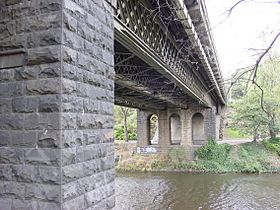Hawthorn Bridge facts for kids
Quick facts for kids Hawthorn Bridge |
|
|---|---|
 |
|
| Coordinates | 37°49′12.4″S 145°0′55.0″E / 37.820111°S 145.015278°E |
| Carries | Bridge Road |
| Crosses | Yarra River |
| Locale | Melbourne, Australia |
| Characteristics | |
| Design | Wrought Iron truss |
| Total length | 98 metres (322 ft) |
| Width | 14.3 metres (47 ft) |
| Longest span | 45.7 metres (150 ft) |
| History | |
| Opened | 1861 |
The Hawthorn Bridge is a very old and important bridge in Melbourne, Australia. It crosses the Yarra River, about 5 kilometers (3 miles) east of the city center. This bridge connects Bridge Road and Burwood Road. It's special because it's the oldest metal bridge still standing over the Yarra River, and one of the oldest in all of Australia! It was built a long time ago, when lots of money came into Victoria because of the Victorian gold rush. The bridge was designed by Francis Bell. It is made of strong wrought iron (a type of metal) and has a special lattice truss design, which looks like a criss-cross pattern. It also has sturdy bluestone supports called abutments (at the ends) and piers (in the middle).
Contents
Building the Hawthorn Bridge
Early Plans and Construction
Plans for the new bridge began on April 21, 1857. The government asked companies to bid on building the bridge's supports. A company owned by J. McKenzie won the bid for £10,000.
The bridge's location was slightly changed to get better foundations. The total cost, including new roads leading to the bridge, was expected to be £40,000. The bluestone supports were supposed to be finished by December 1857. However, they were not ready until February 1858, and cost £10,065.
A Fiery Delay
The metal parts for the bridge were ordered from Britain. These parts were very heavy, about 350 tons! They were shipped to Melbourne in 1859 on a ship called the Herald of the Morning.
But disaster struck! The ship caught fire in Hobsons Bay before it could be unloaded. To put out the fire, the ship was sunk on purpose. This was a huge problem for Melbourne's bridge-building plans. The bridge parts and the cranes needed to build it had cost £10,500.
The companies building the bridge had to order new parts from Britain. This caused a big delay. The new bridge parts finally arrived, and the bridge was finished in November 1861.
Salvaging the Sunken Parts
Even though new parts were ordered, some people tried to save the original bridge materials from the sunken ship. A company called Ingles, Adams, and Gresham bought the wreck. After weeks of hard work, they managed to raise the ship and the bridge parts.
A newspaper reported that the iron bridge parts were "very slightly injured." The company brought the salvaged materials to Sandridge (now Port Melbourne).
A Problem with the Salvaged Parts
Ingles, Adams, and Gresham tried to sell the salvaged bridge materials to the Victorian Government. They asked for £6,000. However, one of the company owners made a serious mistake. He offered a small payment to Thomas Higginbotham, who was in charge of Public Works. This was seen as wrong.
Because of this, the deal with the government was cancelled. The salvage company was also removed from the government's list of approved contractors.
What Happened to the Salvaged Materials?
A local Melbourne factory called Langlands and Co. bought the salvaged bridge materials for £2,000. They spent more money fixing the parts. However, they couldn't find a buyer for all 350 tons of metal.
Eventually, Langlands sold 200 tons of the materials to two country areas, Metcalfe and McIvor. These areas had received money from the government to build the Mia Mia Bridge at Redesdale. They bought the parts for £1,000. Langlands sold the rest of the metal as "scrap iron." The 200 tons of wrought iron had originally cost about £6,000, so the country areas were very happy with their purchase.
Who Designed the Bridge?
It's not completely clear who designed the Hawthorn Bridge. It was a very big project for the Public Works Department at the time. It's possible that Thomas Higginbotham, who was the Inspector-General of Roads and Bridges, helped with the design. He was a skilled engineer. The design and building of the bridge might have also used knowledge from the Melbourne and Suburban Railway Company. This company had built bridges in Cremorne and Hawthorn around 1860-1861.
Changes and Repairs Over Time
Widening the Bridge
In 1885, the Hawthorn Bridge became the end point for Melbourne's very first tram service. To handle more traffic, the bridge was made wider in 1890. This was done by making the piers and abutments longer and adding more metal trusses.
Challenges and Closures
Because the bridge connects two different local areas and has a tram line, there were often problems with who was responsible for its upkeep and how to pay for it. In 1928, there wasn't enough money to fix or replace the bridge. The engineer for the Richmond City declared it unsafe and closed it.
The State Government had to step in. After much discussion, the bridge was repaired, made stronger, and widened again. This work was done using a modern method called in-situ electric arc welding, which means welding was done right on the bridge. The wooden deck was also replaced with strong reinforced concrete.
Today, the top part of the bridge looks like it did in 1931. But the metal trusses, piers, and abutments underneath still look like they did when the bridge was first built in 1861.
The Hawthorn Bridge is an important historical landmark and is listed on the Victorian Heritage Register.

